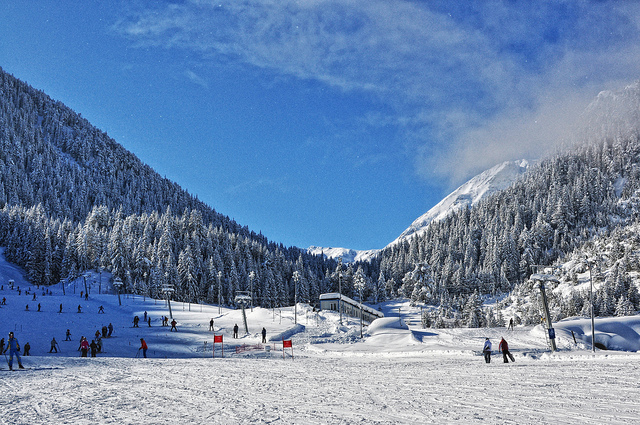Area and Location
The town of Bansko, the newest Bulgarian winter resort, recently discovered by the foreign tourists, is situated in southwestern Bulgaria, at 930 m above the sea level, at the northeastern foot of Pirin Mountain, and beneath the highest and the most beautiful karst part of the mountain. Bansko provides an interesting combination between the virgin nature of Pirin Mountain and the atmosphere of an ancient Bulgarian small town. Pirin is one of the most beautiful Bulgarian mountains - a National Reserve included in the list of UNESCO. It is one of the shiniest jewels in Bulgaria's crown, offering skiing for all abilities in winter and superb hiking in summer.
Bansko is situated 160 km away from Sofia, 150 km from Plovdiv (the second largest city in Bulgaria), 60 km southeast from the town of Blagoevgrad, 6 km south from Razlog, 150 km from the Greek border, and 60 km from the Macedonian border.
Transport
The basic type of transport that connects the town to the rest of the country is bus transport. There are regular bus lines to Sofia, Blagoevgrad, Gotse Delchev and Razlog.
Skiing Conditions
The skiing conditions in Bansko are excellent. Pirin Mountain has a predominately Alpine character with three peaks towering above 2900 m. However, the slopes offer runs and tracks for all types of skiers, from novice to experts. Ski runs are maintained in excellent condition. Snow falls are abundant, providing a constant winter snow cover up to 2 m thick. The skiing season along the Pirin slopes starts in the middle of December and ends in mid April - sometimes until mid May.
The two major ski regions of Bansko - the lower one called Chalin Valog (1100-1600 m) and Shiligarnika (1700-2560 m) are situated above the town, on the northern slopes of Pirin Mountain. There are other ski runs in Banderishka Poljana. The total length of the ski runs in Bansko is 75 km. The longest possible track combo makes a 16 km downhill race. There is 1 gondola lift, 6 four-seat chair lifts, 1 six-seat chair lift, 1 tree-seat chair lift, 2 anchor type tow lifts, 3 single tow lifts, 10 children dragger. Some of the ski runs offer wonderful conditions for night skiing, which is available for everyone from 18.30 until 21.30. Snow boarders can enjoy the first on the Balkans fun- park. It offers the option to ski over present artificial bumps and jumps as well as to build those on their own. Also, the half-pipe located by the place where Bansko’s famous snow towers are usually built, offers both skiers and snowboarders an arena to boast their latest tricks.
Bansko ski schoosl offer classes at five different levels. Certificates are issued to the people who have completed the course. One can benefit from high-quality ski equipment offered by world-famous companies. 24-hour Emergency Rescue Service is available.
The town itself boasts over 120 cultural monuments, and with the aid of the Beautiful Bulgaria Project has turned these buildings into pretty mehanas (taverns) and cosy pensions.
History
Today’s administrative centre of Bansko municipality is located in the place of a settlement that was inhabited in succession by Thracians, Romans, Byzantines and Slavs. The remains of ancient fortresses, Thracian tumuli, mediaeval colonies, consecrated grounds, churches and chapels within the town earthwork testify to several historical epochs. In the Old Town site, about 4 km southwest from the town and in the Yulen site (along the river Damianitsa downstream) there are some remains of ancient fortresses. Thracian burial mounds were discovered close to the Old Town site. The remains of the late mediaeval single-nave St. George and St. Elijah churches, monuments of culture, are to the southeast of Bansko.
Later Bansko was distinguished as an important mercantile and craftsman centre of a new, revival type. Large clans became wealthy; they carried over to their motherland not only the culture of the countries they visited but also they sent their children to study abroad. The contact with the rich European culture had an extraordinary favourable influence on the spiritual progress of the natives of Bansko. The lifestyle of people improved. They built strong two-storey fortress houses of stone with high walls and heavy solid gates, with long eaves of black fir. This style of architecture reached a full bloom during the Revival. The oldest houses of Hadjivalcho, Hadjirusko and Velian were protected by internal coverts and loopholes.
Landmarks and Events
St. Trinity Church is a masterpiece of architecture with the ensemble of old buildings of the same name beside it. The House-museum of Neofit Rilski is an interesting monument of culture. He was born in 1793, and was a patriarch of the Bulgarian education and enlightenment. He studied icon-painting and his teacher was Toma Vishanov – Molera. Later in the Rila Monastery he became a monk.
You can also enjoy one of the most beautiful houses in town – Velianovata. It is situated in the immediate neighborhood of St. Trinity Church. The native house of the Bulgarian poet Nikola Vaptsarov is very beautiful.
A traditional fest in Bansko is the Summer Jazz – Festival with popular performers from Bulgaria. Under the dome of Pirin sky, in the lovely nights of August you can enjoy nice jazz music.
Surroundings
The most impressive one of the surroundings of Bansko is the legendary Pirin Mountain. The biggest part of tourist flow heading for the mountain goes through the town. Just several kilometres south of Bansko is the village of Dobrinishte. It is one of the largest villages in the country with a population of over 3 000 inhabitants. There are 17 mineral springs with water temperature between 30 and 43 C. The area of Pirin National Park is south of Bansko. The localities of Chalin Valog, Todorova Ornitsa, Demyanishka Polyana, Shiligarnika and the chalets of Vihren, Demyanitsa, Bunderitsa, Gotse Delchev and Bezbog offer wonderful conditions for summer and winter tourism and recreation with ski-lifts and rope-lines.



